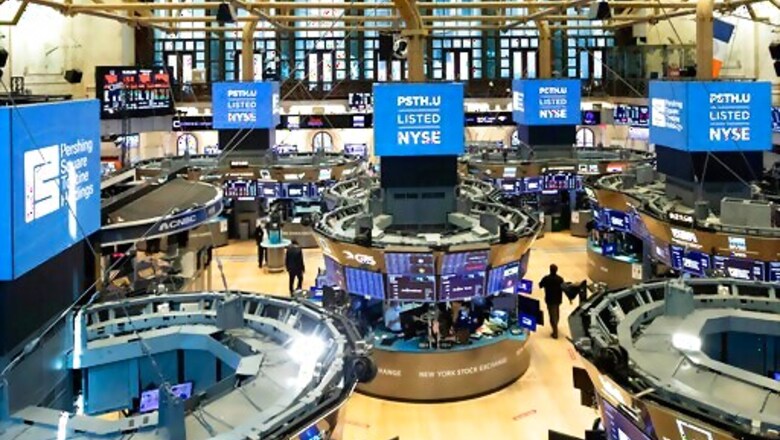
views
Asian shares were mostly higher Wednesday after the S&P 500 logged a fresh all-time high.
Markets in Hong Kong were closed due to a tropical storm.
Japans Nikkei 225 index gained 0.3% to 23,121.32 after the country reported its exports fell 19% in July from a year earlier, better than expected and an improvement over a 26.2% drop in June.
An 8.2% rise in exports to China, the first since early-2019, suggests the recovery there is helping offset weak demand in other markets, said Marcel Thieliant of Capital Economics.
The nearly 21% decline in exports to the U.S. was much better than the 50.6% slump in May, with strong demand for technology allowing people to work from home helping sustain exports of computer chips and electrical machinery, he said. But car exports, which were down 30% year-on-year, remain Japans Achilles heel,” Thieliant said in a commentary.
Worries over trade tensions between the U.S. and China, which threaten to further disrupt trade between the two largest economies, initially pulled the Shanghai Composite index lower but by early afternoon it was less than 0.1% higher, at 3,452.38.
Tech stocks have stumbled recently amid worries that China could retaliate against U.S. moves against network equipment maker Huawei, social media company ByteDance and other Chinese technology giants by targeting U.S. chip makers and others.
The S&P/ASX 500 in Australia jumped 1% to 6,182.40.
Overnight, Wall Street clawed back the last of the dizzying losses unleashed by the new coronavirus, as the S&P 500 picked up 0.2% to 3,389.78, surpassing its previous record closing high of 3,386.15. It was set on Feb. 19, before the pandemic shut down businesses around the world and knocked economies into their worst recessions in decades.
The S&P 500s milestone caps a furious, 51.5% rally that began in late March. The index, which is the benchmark for many stock funds at the heart of 401(k) plans, is now up nearly 5% for the year.
The stock markets sprint back to an all-time high also means that the gut-wrenching, nearly 34% plunge for the S&P 500 from Feb. 19 through March 23 was the quickest bear market on record, clocking in at just one month. The average bear market takes 19.6 months to bottom out, according to S&P Dow Jones Indices.
Tremendous amounts of aid from the Federal Reserve and Congress helped launch the rally, which has progressed on signs of budding growth in the economy.
The Dow Jones Industrial Average fell 0.2% on Tuesday to 27,778.07 and is still 6% below its record set in February. The Nasdaq composite had already returned to a record, thanks to huge gains for the big tech stocks that dominate it. It hit a new one Tuesday, climbing 0.7%, to 11,210.84.
The prolonged rally that has restored much of what was lost in the spring has to be the most curious outcome ever witnessed in the annals of global markets, Stephen Innes of AxiCorp. said in a commentary.
Given the immense issues of where the real economy sits as families struggle to put food on the table and fill up their cars with gas, not to mention we are nowhere near restoring pandemic economic losses as we are still adding those costs up, he said.
Many investors acknowledge the disconnect between the stock market and the broader economy, but they say the rally has been built on top of several supports.
The Federal Reserve and Congress have plowed trillions of dollars into the economy to keep it from plunging even more deeply and to prevent a full-blown financial crisis.
The markets’ recovery is even more noteworthy considering prevailing uncertainties. COVID-19 continues to spread throughout the world, with more than 5.4 million known cases and 170,000 deaths in the United States alone.
Investors are still waiting to see if Congress and the White House can put aside their differences and agree on more aid that analysts say is needed to sustain the recovery that investors have been assuming is on the way. That assumption is a huge reason the stock market is as high as it is.
On Tuesday the government reported that construction of new U.S. homes surged 22.6% last month, the third straight month of gains. With such budding economic improvements in hand, investors are looking ahead to later this year or 2021 when profits recover further and a vaccine for COVID-19 hits the market.
Still, there are signs of skepticism. The yield on the 10-year Treasury dipped to 0.65% from 0.67% late Tuesday. In March, the yield had touched its record low just beneath 0.34%. Last year, it was over 1%.
In energy trading, benchmark U.S. crude for September delivery lost 25 cents to $42.64 per barrel in electronic trading on the New York Mercantile Exchange. It was unchanged at $42.89 per barrel on Tuesday.
Brent crude, the international standard, lost 34 cents to $45.12 per barrel.
The U.S. dollar bought 105.53 Japanese yen, up from 105.46 yen on Tuesday. The euro rose to $1.1939 from $1.1932.
___
AP Business writers Stan Choe, Alex Veiga and Damian J. Troise contributed.
Disclaimer: This post has been auto-published from an agency feed without any modifications to the text and has not been reviewed by an editor




















Comments
0 comment